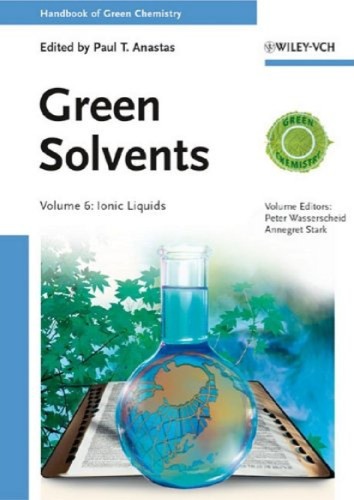

Most ebook files are in PDF format, so you can easily read them using various software such as Foxit Reader or directly on the Google Chrome browser.
Some ebook files are released by publishers in other formats such as .awz, .mobi, .epub, .fb2, etc. You may need to install specific software to read these formats on mobile/PC, such as Calibre.
Please read the tutorial at this link: https://ebookbell.com/faq
We offer FREE conversion to the popular formats you request; however, this may take some time. Therefore, right after payment, please email us, and we will try to provide the service as quickly as possible.
For some exceptional file formats or broken links (if any), please refrain from opening any disputes. Instead, email us first, and we will try to assist within a maximum of 6 hours.
EbookBell Team

4.3
98 reviews
ISBN 10: 3527325921
ISBN 13: 9783527325924
Author: Paul T Anastas
The shift towards being as environmentally-friendly as possible has resulted in the need for this important volume on the role of ionic liquids in green chemistry. Edited by Peter Wasserscheid, one of the pioneers of ionic liquid research, and Annegret Stark, this is an essential resource for anyone wishing to gain an understanding of the world of green chemistry, as well as for chemists, environmental agencies and chemical engineers.
Part I: Green Synthesis
Chapter 1: The Green Synthesis of Ionic Liquids
1.1 The Status Quo of Green Ionic Liquid Syntheses
1.2 Ionic Liquid Preparations Evaluated for Greenness
1.3 Which Principles of Green Chemistry are Relevant to Ionic Liquid Preparations?
1.4 Atom Economy and the E-factor
1.5 Strengths, Weaknesses, Opportunities, Threats (SWOT) Analyses
1.6 Conductive Heating Preparation of 1-Alkyl-3-methylimidazolium Halide Salts
1.7 Purification of 1-Alkyl-3-methylimidazolium Halide Salts
1.8 Ionic Liquid Syntheses Promoted by Microwave Irradiation
1.9 Syntheses of Ionic Liquids Promoted by Ultrasonic Irradiation
1.10 Simultaneous Use of Microwave and Ultrasonic Irradiation to Prepare Ionic Liquids
1.11 Preparation of Ionic Liquids Using Microreactors
1.12 Purification of Ionic Liquids with Non-halide Anions
1.13 Decolorization of Ionic Liquids
1.14 Conclusion
References
Part II: Green Synthesis Using Ionic Liquids
Chapter 2: Green Organic Synthesis in Ionic Liquids
2.1 General Aspects
2.2 Friedel–Crafts Alkylation
References
Chapter 3: Transition Metal Catalysis in Ionic Liquids
3.1 Solubility and Immobilization of Transition Metal Complexes in Ionic Liquids
3.2 Ionic Liquid–Catalyst Interaction
3.3 Distillative Product Isolation from Ionic Catalyst Solutions
3.4 New Opportunities for Biphasic Catalysis
3.5 Green Aspects of Nanoparticle and Nanocluster Catalysis in Ionic Liquids
3.6 Green Aspects of Heterogeneous Catalysis in Ionic Liquids
3.7 Green Chemistry Aspects of Hydroformylation Catalysis in Ionic Liquids
3.8 Conclusion
References
Chapter 4: Ionic Liquids in the Manufacture of 5-Hydroxymethylfurfural from Saccharides. An Example of the Conversion of Renewable Resources to Platform Chemicals
4.1 Introduction
4.2 HMF Manufacture
4.3 Goals of Study
4.4 HMF Manufacture in Ionic Liquids – Results of Detailed Studies in the Jena Laboratories
4.5 Conclusion
References
Chapter 5: Cellulose Dissolution and Processing with Ionic Liquids
5.1 General Aspects
5.2 Dissolution of Cellulose in Ionic Liquids
5.3 Rheological Behavior of Cellulose Solutions in Ionic Liquids
5.4 Regeneration of the Cellulose and Recycling of the Ionic Liquid
5.5 Cellulosic Fibers
5.6 Cellulose Derivatives
5.7 Fractionation of Biomass with Ionic Liquids
5.8 Conclusion and Outlook
References
Part III: Ionic Liquids in Green Engineering
Chapter 6: Green Separation Processes with Ionic Liquids
6.1 Introduction
6.2 Liquid Separations
6.3 Environmental Separations
6.4 Combination of Separations in the Liquid Phase with Membranes
6.5 Gas Separations
6.6 Engineering Aspects
6.7 Design of a Separation Process
6.8 Conclusions
References
Chapter 7: Applications of Ionic Liquids in Electrolyte Systems
7.1 Introduction
7.2 Electrolyte Properties of Ionic Liquids
7.3 Electrochemical Stability
7.4 Dye-sensitized Solar Cells
References
Chapter 8: Ionic Liquids as Lubricants
8.1 Introduction
8.2 Why Are Ionic Liquids Good Lubricants?
8.3 Applications, Conclusion and Future Challenges
References
Chapter 9: New Working Pairs for Absorption Chillers
9.1 Introduction
9.2 Absorption Chillers
9.3 Requirements and Challenges
9.4 State of the Art and Selected Results
9.5 Abbreviations
References
Part IV: Ionic Liquids and the Environment
Chapter 10: Design of Inherently Safer Ionic Liquids: Toxicology and Biodegradation
10.1 Introduction
10.2 (Eco)toxicity of Ionic Liquids
10.3 Biodegradability of Ionic Liquids
10.4 Conclusion
References
Chapter 11: Eco-efficiency Analysis of an Industrially Implemented Ionic Liquid-based Process – the BASF BASIL Process
11.1 The Eco-efficiency Analysis Tool
11.2 The Methodological Approach
11.3 The Design of the Eco-efficiency Study of BASIL
11.4 Selected Single Results
11.5 The Creation of the Eco-efficiency Portfolio
11.6 Scenario Analysis
11.7 Conclusion
11.8 Outlook
References
Chapter 12: Perspectives of Ionic Liquids as Environmentally Benign Substitutes for Molecular Solvents
12.1 Introduction
12.2 Evaluation and Optimization of R&D Processes: Developing a Methodology
12.3 Assessment of Ionic Liquid Synthesis – Case Studies
12.4 Assessment of the Application of Ionic Liquids in Contrast to Molecular Solvents
12.5 Conclusions
References
Index
End User License Agreement
handbook of green chemistry pdf
handbook of green chemistry green solvents
handbook of green analytical chemistry
handbook of green analytical chemistry pdf
handbook of chemistry and physics pdf
Tags: Paul T Anastas, Chemistry, Green